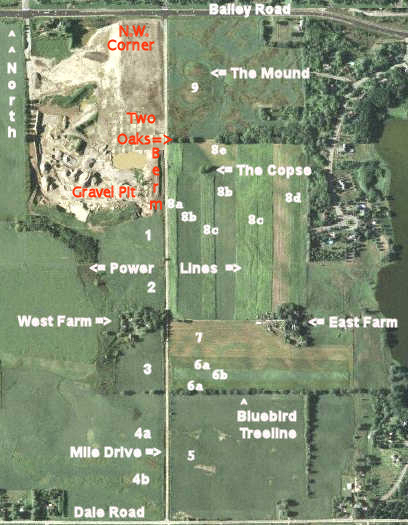
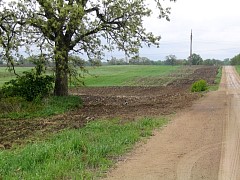 After a dry April we've had a bit of rain here in May. Enlarge this photo and look under
the tree - two ducks are using the tree canopy for an umbrella ...
After a dry April we've had a bit of rain here in May. Enlarge this photo and look under
the tree - two ducks are using the tree canopy for an umbrella ...
|
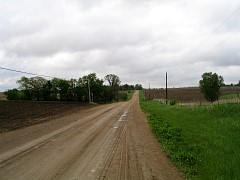 ... a little farther down the road.
... a little farther down the road.
|
|
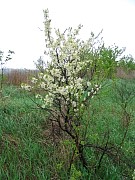
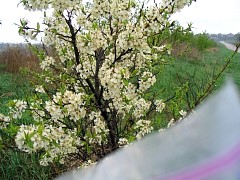 These pretty fragrant blooms on the berm across from Two Oaks are Wild Plum (Prunus americana).
Plum trees bloom before leaves appear. Trees send out underground suckers and
can form large colonies
I have the camera in a plastic
bag because of the rain, and manage to get it in the picture. This area along the road
will be obliterated by summertime, so I include the picture as part of the record.
Return to Flora
These pretty fragrant blooms on the berm across from Two Oaks are Wild Plum (Prunus americana).
Plum trees bloom before leaves appear. Trees send out underground suckers and
can form large colonies
I have the camera in a plastic
bag because of the rain, and manage to get it in the picture. This area along the road
will be obliterated by summertime, so I include the picture as part of the record.
Return to Flora
|
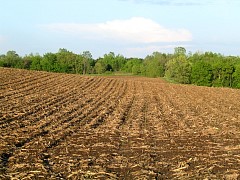
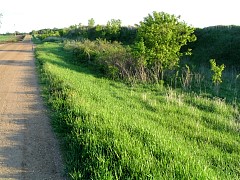
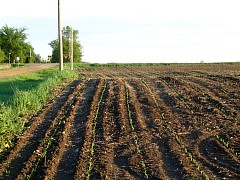 Above, far left is corn coming up in Field #9. Above, middle, is the ditch across from Two Oaks.
Above, far right is corn coming up in Field #4.
Above, far left is corn coming up in Field #9. Above, middle, is the ditch across from Two Oaks.
Above, far right is corn coming up in Field #4.
|
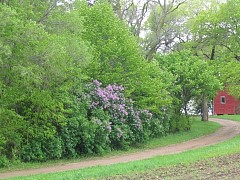
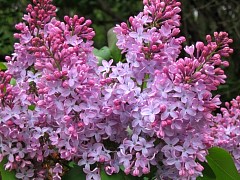 Here along the driveway of the West Farm are common lilac bushes. From the old-fashioned common lilac
(Syringa vulgaris) and others, many hybrids
have been developed with variations in form (such as double flowers) and in color (such as rosy pink
and white).
Lilacs are native to southeast Europe. Lilacs are hardy, persisting long after abandonment,
marking former homestead sites.
Leaves, opposite; simple; heart-shaped, 5-12 cm long. Flowers, fragrant; lilac, pink purple or white, four
petals forming a tube, about 12 mm long, borne in large inverted cone-shaped clusters.
Return to Flora
Here along the driveway of the West Farm are common lilac bushes. From the old-fashioned common lilac
(Syringa vulgaris) and others, many hybrids
have been developed with variations in form (such as double flowers) and in color (such as rosy pink
and white).
Lilacs are native to southeast Europe. Lilacs are hardy, persisting long after abandonment,
marking former homestead sites.
Leaves, opposite; simple; heart-shaped, 5-12 cm long. Flowers, fragrant; lilac, pink purple or white, four
petals forming a tube, about 12 mm long, borne in large inverted cone-shaped clusters.
Return to Flora
|
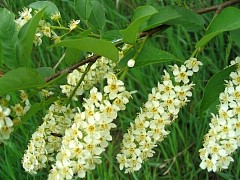
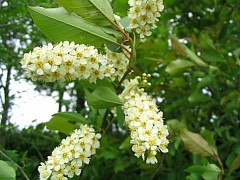
These blooms are stunning. I can't identify it positively.
Farmers and farm wives took pride in their homes, and
these shrubs still display this pride long after the Elke's are gone.
Perhaps these flowering bushes are from nearby Bailey Nursery.
Before Bailey Nursery (founded 1905) became
strictly a wholesale nursery business in 1957, it featured a
retail nursery and a landscape business. Return to Flora
|
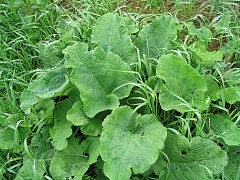
This is the early version of common burdock (Arctium minus) also called wild rhubarb.
Apparently, the stout taproot has a sweet taste and can be used as food.
|
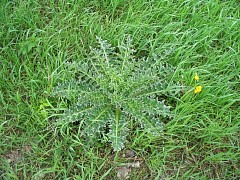
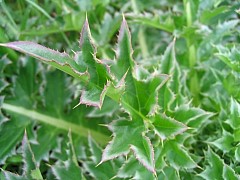
This is the intimidating precursor of an adult nodding thistle (Carduus Nutans). The
needles prevent livestock from eating it. Later
on in June we will see the big purple flowers that are the trademark of this prickly plant.
|
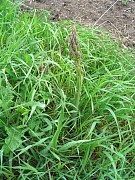
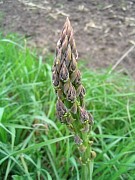
Since ancient times, asparagus (Asparagus officinalis) has been thought to have special
healthful qualities. The harvesting the wild asparagus, famous for their medicinal qualities, was
a springtime ritual. Wild asparagus is native to coastal regions of Europe and Asia, and was brought to
North America by European settlers in the 1700’s. It is commonly cultivated in gardens, and often
escapes, becoming established in waste places, along roadsides and fence rows. Wild asparagus produces
a thick mat of fleshy roots that can grow 3 feet deep
Return to Consumables
|
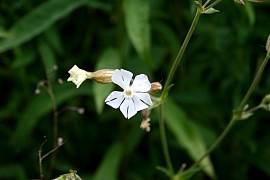
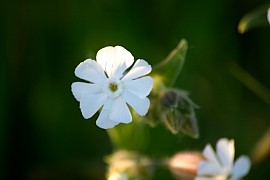
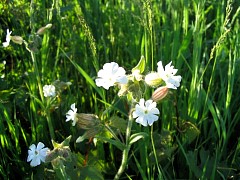
|
|
This is white cockle, also known as white campion (Silene pratensis)
White campion was introduced into North America from Europe in the early 1800’s most likely in
contaminated crop seeds. This species is characterized by downy foliage and showy white flowers,
whose petals emerge from a green, inflated, bladder-like structure (calyx). There is a male
plant and a female plant. Flowers open at night and release a sweet scent, attracting moths for
pollination. Return to Flora
|
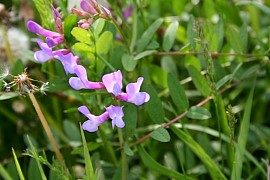
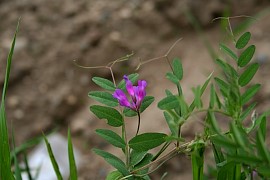
Spring Vetch (Vicia lathyroides) are readily consumed by livestock.
This member of the Pea family sports one or two, ¾ to 1-inch long,
bicolored purple and pink flowers in the leaf axils.
Return to Flora
|
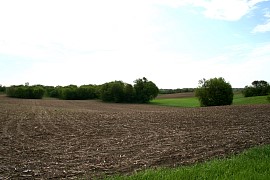
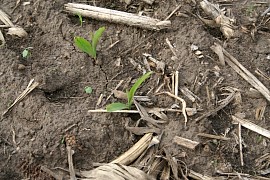
The corn is sprouting in Field #9
|
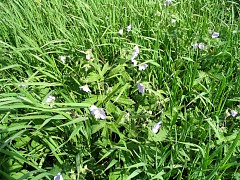
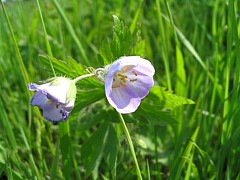
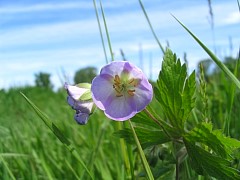
|
|
Canada Anemone (Anenome canadensis). Anemone may come from the Greek word for "wind".
The root and leaves of this plant was one of the most highly esteemed medicines of the Omaha and Ponca
Indians. Tea from the roots was used to treat dizziness and headache - The root was eaten to
clear the throat
so that a person could sing well. The flowers are hermaphrodite (has both male and female organs) and
are pollinated by bees and flies. Return to Flora
|
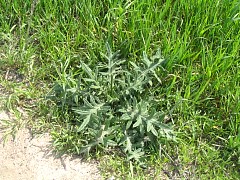
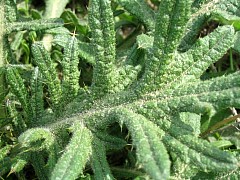
I believe this will turn out to be Canada thistle (Cirsium arvense). One plant can colonize an
area 3 to 6 feet in diameter in one or two years. Washington county sends out road crews
to destroy patches of thistle.
|
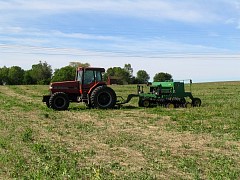
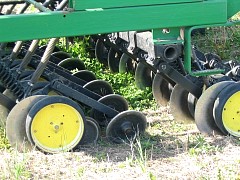
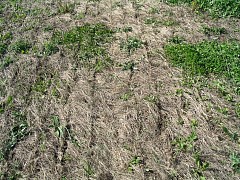
|
|
Field #1 is being planted in soybeans, having laid fallow the year before. When I came back to
this spot from the other direction, I talked to two farmers who were taking the farm equipment away.
This field is being farmed in the manner called Roundup Ready. Roundup
is a broadleaf weed killer. There were more than 3,000 different varieties of soybean
seed available; more than 1,100 varieties are Roundup Ready. The planter behind the tractor
laid out the soybean seeds is small trenches cut into the unplowed field. Very soon the
farmer will return and Roundup weed killer will be sprayed on this field, killing every plant.
But the soybean seeds are genetically altered so that Roundup won't kill them. The soybeans
grown here are to be fed to cattle - not people - so in the United States it's allowed.
These two gentlemen told me that years ago there were forty working dairy farms here in
Woodbury. The soil in Field #1 is very sandy and dries out quickly - the very sand that
attracted the gravel pit to the northern border of Field #1. The farmer planting this field
had borrowed the planter from the other farmer. Both men appeared in their early 60's.
|
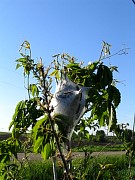
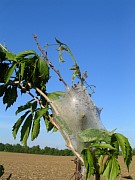
The eastern tent caterpillar, (Malacosoma americanum), is a pest native to North America.
Defoliation of trees, building of unsightly silken nests in trees, and wandering caterpillars crawling
over plants, walkways, and roads cause this insect to be a pest in the late spring and early summer
The eastern tent caterpillar over winters as an egg, within an egg mass of 150 to 400 eggs. These masses
are covered with a shiny, black varnish-like material and encircle branches that are about pencil-size
or smaller in diameter. The caterpillars hatch about the time the buds begin to open. These insects
are social; caterpillars from one egg mass stay together and spin a silken tent in a crotch of a
tree. Caterpillars from two or more egg masses may unite to form one large colony. During the
heat of the day or rainy weather, the caterpillars remain within the tent. They emerge to feed on
leaves in the early morning, evening, or at night when it is not too cold. As the larvae feed on the
foliage, they increase the size of the web until it is a foot or more in length. In 4 to 6 weeks
the caterpillars are full grown and 2 to 2-1/2 inches long. At this time, they begin to wander away
individually from the nest in search of protected areas to spin a cocoon. The cocoon is about 1
inch long and made of closely woven white or yellowish silk and is attached to other objects by a
few coarser threads. The adult moth emerges from the cocoon about 3 weeks later. The moth is
reddish-brown with two pale stripes running diagonally across each forewing. Moths mate and
females begin to lay eggs on small branches. The eggs will hatch next spring. There is just
one generation per year.
|